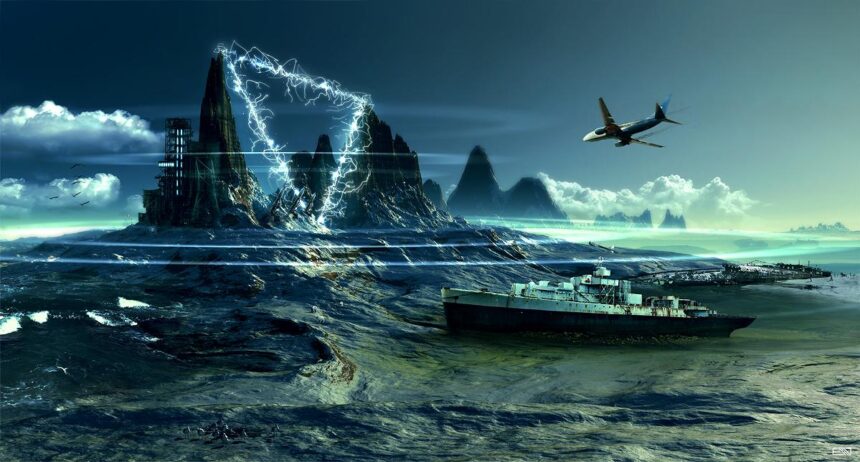Few places on Earth evoke as much intrigue and unease as the Bermuda Triangle, a vast expanse of ocean often blamed for the inexplicable vanishings of ships, planes, and countless souls. Stretching across 500,000 square kilometers in the Atlantic, this notorious region—bounded by Bermuda, Miami, Florida, and San Juan, Puerto Rico—has become synonymous with mystery.
Over the past century, it has been linked to over 100 disappearances of aircraft and vessels, claiming an estimated 1,000 lives. From tales of malfunctioning compasses to theories of alien abductions, the Bermuda Triangle has fueled endless speculation. But what lies behind these vanishings? Are they the work of natural phenomena, human error, or something more sinister? Let’s dive deep into the history, the most famous cases, and the ongoing debate surrounding this enigmatic “Devil’s Triangle.”
Defining the Bermuda Triangle: A Region Shrouded in Legend
Nestled off the southeastern coast of the United States, the Bermuda Triangle covers a triangular swath of the Atlantic Ocean, connecting three key points: Bermuda (a British Overseas Territory), Miami (a bustling Florida hub), and San Juan (Puerto Rico’s vibrant capital). Spanning roughly 500,000 to 1,500,000 square kilometers, depending on how it’s measured, this area is a busy corridor for maritime and air traffic. Yet, despite its strategic location, it’s gained a chilling reputation as a graveyard for the unwary.
Over the last 100 years, the Triangle has been associated with a staggering number of disappearances—planes vanishing mid-flight, ships lost without a trace, and crews never heard from again. Unlike other treacherous waters where coral reefs or storms might explain such losses, many of these incidents defy easy explanation. The U.S. Coast Guard, however, maintains that nothing extraordinary is afoot, asserting that the region’s disappearance rates align with global norms. So, why does the Bermuda Triangle loom so large in the public imagination? To answer that, we must trace its origins and examine its most iconic cases.
The Birth of a Myth: How the Bermuda Triangle Became Infamous
The Bermuda Triangle’s mystique crystallized in the mid-20th century, though strange tales from the region predate its formal naming. The turning point came on December 5, 1945, with the disappearance of Flight 19—a squadron of five U.S. Navy bombers that vanished during a routine training mission. This incident, widely publicized, marked the Triangle’s entry into popular lore. Reporter E.V.W. Jones seized on the event, compiling a list of “mysterious disappearances” between Florida and Bermuda in a 1947 article. Two years later, George X. Sand’s piece in Fate magazine amplified the narrative, detailing maritime enigmas and igniting public fascination.
The name “Bermuda Triangle” was cemented in 1964 by Vincent Gaddis in Argosy magazine’s article “The Deadly Bermuda Triangle.” Gaddis’s evocative title stuck, and the legend snowballed. Books, films, and sensationalized “studies” followed, weaving theories ranging from extraterrestrial interference to sea monsters. As older shipwrecks were retroactively tied to the Triangle, its reputation as a paranormal hotspot grew, overshadowing more mundane explanations.
The Numbers Game: How Many Have Vanished?
Estimates of the Bermuda Triangle’s toll vary widely. Reports often cite over 100 lost aircraft and ships, with a human cost exceeding 1,000 lives. In 1975, Mary Margaret Fuller, editor of Fate magazine, sought hard data from Lloyd’s of London, the famed insurance market. Their records showed 428 vessels reported missing in the Triangle between 1955 and 1975. Yet Lloyd’s downplayed the figure, noting that the region’s loss rate wasn’t unusually high compared to other busy sea lanes.
Author Gian J. Quasar, in his exhaustive book Into the Bermuda Triangle: Pursuing the Truth Behind the World’s Greatest Mystery, challenges this view. He argues that Lloyd’s statistics miss the full picture, as the company doesn’t typically insure small boats or private aircraft—categories often involved in Triangle vanishings. After a 12-year battle with the U.S. Coast Guard to access detailed records, Quasar uncovered evidence of 300 missing vessels in just two years—a far cry from official dismissals. This discrepancy fuels the debate: Is the Triangle a statistical anomaly or a victim of selective storytelling?
The Most Famous Disappearances: Tales That Define the Legend
The Bermuda Triangle’s allure rests on its roster of baffling cases—incidents that resist explanation and keep the mystery alive. Here are five of the most iconic:
1. USS Cyclops (1918): A Wartime Vanishing
During World War I, the USS Cyclops, a massive Navy collier, set sail from Rio de Janeiro on February 16, 1918, bound for Baltimore with a stop in Barbados on March 3–4. Carrying 306 crew and passengers, the ship was last heard from as it departed Barbados. Then, silence. No distress calls, no wreckage—just an empty sea. Theories abound: Was it sunk by a German U-boat? Overwhelmed by a storm? Or lost to some unseen force? The Cyclops remains one of the Navy’s greatest unsolved mysteries.
2. Flight 19 (1945): The Spark of the Myth
On December 5, 1945, five TBM Avenger torpedo bombers—collectively known as Flight 19—took off from Fort Lauderdale, Florida, for a routine training exercise. Led by experienced pilots, the squadron soon reported disorientation. Radio transmissions captured their confusion: compasses failed, landmarks vanished, and one pilot exclaimed, “Everything looks strange, even the ocean.” Contact was lost, and a massive search ensued. Adding to the enigma, one of the PBM-5 Mariner rescue planes sent after them exploded mid-flight. Neither the bombers nor their 14 crewmen were ever found, cementing Flight 19 as the Triangle’s signature tragedy.
3. Flight NC-16002 (1948): A Vanishing Approach
On December 28, 1948, Captain Robert Lindquist piloted the commercial DC-3 flight NC-16002 from San Juan, Puerto Rico, to Miami. With 29 passengers aboard, the plane neared Miami and requested landing clearance. The control tower responded, but the aircraft never replied. It simply disappeared—no wreckage, no distress signal. Weather conditions were clear, and Lindquist was seasoned. The sudden silence of NC-16002 remains a haunting puzzle.
4. SS Marine Sulphur Queen (1963): A Tanker Lost to the Void
The SS Marine Sulphur Queen, a 524-foot tanker, departed Beaumont, Texas, on February 2, 1963, carrying 15,000 tons of molten sulfur to Norfolk, Virginia. On February 3, the captain radioed routine updates. That was the last anyone heard from the ship or its 39 crew members. A Coast Guard search recovered only a life jacket and a few debris fragments—no hull, no answers. Theories range from structural failure to an explosion caused by the volatile cargo, but the Sulphur Queen’s fate remains speculative.
5. Aircraft 680 (1965): A Clear-Night Mystery
On a calm night in 1965, a U.S. Air Force plane from the 440th Fighter Wing departed Milwaukee for the Bahamas. The experienced crew maintained normal communication with air traffic control, reporting no issues. Yet the aircraft never reached its destination. No distress call, no crash site—just an abrupt end. The clear weather and skilled pilots deepen the enigma of Aircraft 680’s disappearance.
Separating Fact from Fiction: The Mary Celeste Misstep
Not every tale tied to the Bermuda Triangle holds up. The Mary Celeste, found adrift in 1872 with no crew aboard, is often cited as a Triangle mystery. In truth, it was discovered near the Azores, hundreds of miles outside the Triangle’s boundaries. Such misattributions highlight how the myth has grown, absorbing unrelated events to bolster its mystique.
Theories and Explanations: What’s Really Happening?
The Bermuda Triangle’s enduring enigma has spawned countless theories. Paranormal enthusiasts point to alien abductions, time warps, or sea monsters like giant octopuses. More grounded explanations include:
- Natural Phenomena: Methane gas eruptions from the seafloor could sink ships by reducing water density, while rogue waves or sudden storms might overwhelm vessels and planes.
- Human Error: The Triangle’s heavy traffic and tricky navigation—compasses can misalign due to magnetic anomalies—may account for many losses.
- Hoaxes and Hype: Sensationalized reporting and fabricated details have exaggerated the region’s dangers.
The U.S. Coast Guard and NOAA argue that the Triangle’s incidents align with expected risks in a busy, unpredictable ocean corridor. Yet skeptics like Quasar counter that official records underreport the true scale, keeping the debate alive.
The Bermuda Triangle Today: A Mystery That Endures
As of April 5, 2025, the Bermuda Triangle remains a cultural touchstone, its legend undimmed by scientific rebuttals. Whether a genuine anomaly or a product of human imagination, it continues to captivate—a reminder of how little we sometimes understand about the world we inhabit. Each passing year brings new scrutiny, but the Triangle guards its secrets well. Will future technology finally unravel its mysteries, or will it forever remain the “Devil’s Triangle”? Only time—and perhaps the sea itself—will tell.

















